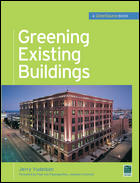
December 19, 2011—Green building consultant Jerry Yudelson, CEO of Yudelson Associates, recently released his annual list of green building trends for 2012, and posits that green building will continue its rebound globally in 2012 in spite of ongoing economic difficulties in most developed economies.
In putting together his top ten trends for 2012, Yudelson says he took advantage of conversations with green building industry leaders in the United States, Canada, Europe, Asia, the Middle East and Australia during the past year.
His top 10 green building megatrends include:
- Green building in North America will rebound in 2012, using new LEED (Leadership in Energy and Environmental Design) project registrations as a proxy for this growth.
- Green building will continue to benefit from the Obama Administration’s strengthened focus on greening the executive branch, with its commitment to a minimum of LEED Gold for all federal projects and focus on major energy-efficiency renovations.
- The focus of the green building industry will continue its switch from new building design and construction to greening existing buildings. One fast-growing LEED rating system the past two years has been LEED for Existing Buildings Operations and Maintenance (LEED-EBOM), with cumulative floor area in certified projects now greater than in new construction, and it is expected that this trend will pick up in 2012.
- Awareness of the coming global crisis in fresh water supply will increase, with building designers, owners and managers taking further steps to reduce water consumption in buildings.
- The global green building movement will continue to accelerate, as more countries begin to create their own green building incentives and develop their own Green Building Councils.
- Zero-net-energy buildings will become increasingly commonplace, in both residential and commercial sectors, as LEED and ENERGY STAR certifications and labels have become too commonplace to confer competitive advantage among building owners.
- Performance disclosure will be the fastest emerging trend, highlighted by new requirements in California, Seattle and other locations. Commercial building owners will have to disclose actual building performance to all new tenants and buyers and in some places, to the public at large.
- Green buildings will increasingly be managed in the “Cloud,” as witnessed by the large number of new entrants and new products in fields of building automation, facilities management, wireless controls and information management in 2011.
- Local and state governments will step up their mandates for green buildings for both themselves and the private sector. The desire to reduce carbon emissions by going green will lead more government agencies, universities, hospitals and corporate owners to require green buildings from design and construction teams.
- Solar power use in buildings will continue to grow with the prospect of increasing utility focus on aggressive state-level renewable power standards for 2020. As before, third-party financing partnerships will continue to grow and provide capital for large rooftop systems such as on warehouses and big box retail stores. There will be fewer very large solar and wind systems, as federal support begins to decline.
- Green building will continue to benefit from the Obama Administration’s strengthened focus on greening the executive branch, with its commitment to a minimum of LEED Gold for all federal projects and focus on major energy-efficiency renovations.




